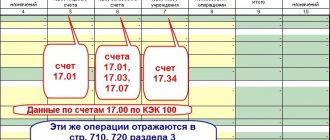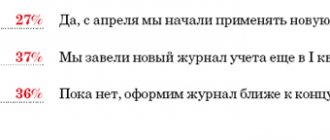Is it worth opening a bank account for an individual entrepreneur?
Considering that cash flow may raise questions for a credit institution, entrepreneurs often decide to work without a current account. This is convenient because you don’t have to wait for the bank to transfer the money. In addition, some contractors offer a discount when paying in cash.
The law does not oblige individual entrepreneurs to open a bank account, but this is a convenient tool for entrepreneurs who run a legal business. In addition, large payments (from 100 thousand rubles) to counterparties can only be made in cashless form. This rule does not apply to cash payments with clients and customers in smaller amounts.
In general, a bank account is reliable and convenient. Funds in the account can be used to pay for goods and services, rent, employee salaries, interest on loans, taxes, etc. This makes it easier for an entrepreneur to control the receipt and expenditure of funds, and in a credit institution money is safer than, say, in the cash register of an enterprise. Of course, it happens that banks close, so it’s worth choosing a credit institution to open a current account not only based on the size of the commission, but also on reliability.
Bank account for individual entrepreneurs - a convenient financial management tool
How much money should I keep in my current account?
It is worth remembering that individual entrepreneurs’ funds in banks are insured for up to 1.4 million rubles. True, entrepreneurs will receive compensation only after all obligations to individuals have been covered. Therefore, experts recommend storing available funds not in the individual entrepreneur’s account, but in the personal account of the individual.
How to withdraw money from an individual entrepreneur’s current account: limits, goals and accounting
Hello! In this article we will talk about ways to cash out an individual entrepreneur’s current account.
Today you will learn:
- For what purposes is it permissible to withdraw money from an individual entrepreneur’s current account?
- How can I get cash?
- What needs to be indicated in the payment instructions when withdrawing funds for personal purposes.
The law does not oblige individual entrepreneurs to open a current account for business purposes. If it is more convenient for you to pay in cash, you have the right to use only cash. This happens in cases where counterparties prefer to pay in cash. And since operations involve the presence of only real money, then there is no need to maintain a settlement account.
However, there are situations that oblige an individual entrepreneur to open a bank account in the name of the company. The legislation limited the amount of transfers between individual entrepreneurs and other companies to 100,000 rubles.
If you are going to sign a contract for a high price (even for 101,000 rubles), then you will have to open a bank account for these purposes. This restriction applies only to settlements with other legal entities. It does not apply to individuals.
An account is also necessary if your business partners do not work with cash. To maintain contacts with profitable counterparties, it is better to get an account.
Having a current account provides some advantages to individual entrepreneurs:
- It's comfortable. All expenses and income are calculated using one account. You can always make an extract from it for any period and calculate the total costs for various purposes;
- Suppliers/contractors trust companies that have an invoice more. The individual entrepreneur looks more reliable in the eyes of the other party to the transaction.;
- There are no restrictions on transaction limits. You have the right to make transfers for any amounts. There are only internal limits on bank tariffs. This is due to the fight against criminal fraud involving the illegal withdrawal of funds for unacceptable purposes.
Spending goals
Expenses on a current account must be related to the characteristics of an open business. If suspicious transactions are carried out on your account, the nature of which does not relate to the company’s activities, the bank may impose a ban on using the account until the circumstances are identified.
What the law says
Since an individual entrepreneur has the status of an individual, and not a separate organization, all funds are his personal property, which he can use as he pleases. In accordance with the Civil Code of the Russian Federation (Article 209), the owner has the rights to own, use and dispose of property, which includes the money of an individual entrepreneur.
It is worth considering that there is Law No. 115-FZ “On combating the legalization of proceeds from crime,” according to which banks must identify suspicious transactions and verify them. Withdrawing large amounts from an individual entrepreneur's account may arouse the interest of a credit institution, especially if you often withdraw cash in large amounts - from 600 thousand rubles. In this case, the bank may ask what you spend the money on, so it is useful to have documents confirming the expenses.
An entrepreneur who has paid the budget on time and in full can freely use the remaining funds for personal needs.
Purpose of withdrawal
A small business representative with the status of an individual entrepreneur has the right to withdraw funds from a business account for personal needs, to ensure the functioning of the business and to fulfill the obligations formed as a result.
Several areas for spending funds have been identified, which are indicated in the comments section of the payment documentation. Some positions will have to be confirmed with additional documents.
An entrepreneur can withdraw funds from a current account to ensure:
- payment of wages to employees;
- payment of mandatory payments to authorized bodies;
- carrying out business transactions;
- rental fees for premises and equipment;
- conducting settlements with counterparties;
- own needs.
The fact of conducting a financial cash transaction is documented. For each transaction, the bank issues a receipt to the person who initiated the procedure with the signature of the responsible employee performing the transaction and the seal of the institution.
Legislative regulation
The Civil Code of the Russian Federation regulates the ability of an individual entrepreneur to use funds received as a result of the functioning of a business to meet personal needs.
Legal acts define the need to separate the direction of spending money. To implement this task, individual entrepreneurs are recommended to have two plastic cards. At the same time, one of them must be opened from an individual, and the second from a business representative.
In this perspective, money for different purposes is transferred to different cards. The law does not provide for a restriction on the withdrawal of personal funds, however, when making payments for business needs, the limit of 100,000 rubles applied for one agreement is relevant.
Nuances of withdrawing funds from individual entrepreneurs to support entrepreneurial activities
Withdrawal through a personal card
Withdrawal of money from an individual entrepreneur's current account is carried out in accordance with certain regulations. All transactions of the entrepreneur, the subject of which are cash, must be carried out in compliance with cash discipline. The provisions of legal acts do not oblige individual entrepreneurs to maintain cash documentation. However, in practice, the simplified procedure can lead to disputes and disagreements with tax authorities when determining the tax base. Therefore, it is better not to neglect the documentation of such procedures.
If a small business representative often withdraws money from a current account in an amount exceeding 100,000 rubles, then it is within the competence of the banking institution to require documentary evidence in the form of prepared statements reflecting the direction of further spending of the cash. The check is carried out as part of the implementation of the law on combating legalization of proceeds from crime.
The expenditure of cashed funds for business purposes must be documented.
To do this, it is necessary to draw up agreements with counterparties and payment documentation, as well as ensure their proper storage.
When responding to a request from authorized bodies, an entrepreneur will probably have to refer to invoices, delivery notes, as well as cash and sales receipts.
How to find out loan debts by last name for free
If the money was withdrawn to pay wages to hired employees, then it is necessary to prepare a statement in the T-53 form. An individual entrepreneur is not required to prepare transaction entries, since the law does not determine the need to use such an accounting tool in accounting for its activities.
The difference between an entrepreneur and an LLC founder is his ability to spend the money he earns for personal purposes. Withdrawn money is not subject to additional taxes. They can be spent in unlimited quantities. A small business representative does not need to prepare advance statements for the amount of cash spent by him.
For comparison, the founder of a company can cash out funds only by ordering the payment of dividends, which is provided within the time limits provided for by the charter.
For funds received classified as his income category, the LLC participant will have to pay an additional 13 percent.
Receiving cash from an entrepreneur's current account for any personal needs is possible in several ways:
- at the cash desk of a banking institution where individual entrepreneurs are served by payment order or by check;
- transfer to a bank card of an individual;
- transfer to a savings or deposit account with subsequent withdrawal according to a simplified scheme.
Receipt through the cashier
When receiving money through a cash register, in the purpose of payment in the payment order, it is necessary to indicate that the funds are issued for personal needs.
Some entrepreneurs strive to minimize the cost of bank commissions and indicate in the purpose of payment that the money belongs to the category of the individual entrepreneur’s salary.
This interpretation is incorrect, and the bank has the right to refuse to carry out the transaction, citing an incorrectly executed order, since the provisions of the legal act regulate that the entrepreneur does not have the right to charge and pay himself wages.
Transfer to card
Withdrawal on a paid order
When making a transfer to a plastic card, it is important that it is issued to the entrepreneur. If the banking product belongs to another person, then the funds received on the card are subject to taxation on the income received by the individual. In such a situation, the entrepreneur, when making a transaction, must withhold and transfer the amount of personal income tax to the budget.
When using card and current accounts opened in different banks for a transaction, the entrepreneur must expect to pay an additional commission.
When making a transfer to your card, the bank does not charge a cash withdrawal fee, since in fact the individual entrepreneur does not withdraw money as a result of such an operation. He receives funds in his hands by withdrawing them through an ATM. The commission is withdrawn in accordance with the procedure relevant for servicing the banking product. For some types of cards it is not provided.
Transfer to savings account
An entrepreneur can have not only a current account, but also a savings account. The transfer transaction is processed according to the standard scheme that is relevant for card transactions. Depending on the procedure for servicing the account, money must be withdrawn immediately after it is received or within a certain period of time.
Banking nuances
A banking operation to withdraw funds from a current account is only possible with a commission. Its value is determined by the purpose of further spending of money.
If it is planned to pay wages to employees in cash, then its size is not very large, and rarely reaches one percent.
When withdrawing for any other purpose, which may be personal or business in nature, the commission reaches 2 percent. Its value is also influenced by the withdrawal amount.
What's the best way to cash out?
Assessing the algorithm for carrying out all types of withdrawal operations, it should be noted that the most profitable and convenient method of cashing out is making transfer transactions between settlement and card accounts. To implement the procedure, it is not necessary to visit a bank branch. Modern opportunities allow you to solve the problem through Internet banking or by phone.
It is better not to use cash payments with employees and contractors in terms of financial activities of a business. To eliminate the complexity of processing cash transactions and the need to pay commission interest, it is easier to work with all business participants by bank transfer.
Before concluding a service agreement with a bank, it is recommended that you familiarize yourself with the terms of cooperation and analyze them in order to identify pitfalls. Some financial organizations, when making a transfer, instead of a fee for cash withdrawal, charge the client a transfer fee, the amount of which may exceed the same values current for cash withdrawal.
When security intervenes in a transaction
Each financial institution has its own service parameters. They will determine transfer limits and the time of day at which they are relevant for entrepreneurs.
Any amount received into the account must be documented by an agreement or checks.
Their absence may be grounds for the security service to suspect the dishonest nature of the transactions, which they are obliged to report to the authorized bodies for further proceedings.
Withdrawing funds for personal needs
An entrepreneur can withdraw funds from his current account for personal needs at any time. At the same time, the position of an individual entrepreneur is much more advantageous than that of an LLC: the owner of a limited liability company can cash out funds only by paying them to himself in the form of dividends. This can be done provided the company makes a profit and no more often than once every three months, while personal income tax is withheld at 13%.
The funds that remain in the current account of an individual entrepreneur after paying taxes, fees and obligatory payments can be used by him for personal purposes. The Tax Code does not provide for taxation of amounts of funds transferred from the current account of an individual entrepreneur to the account of an individual.
Deputy Director of the Department of Tax and Customs Tariff Policy of the Ministry of Finance of the Russian Federation Ruben Sahakyan
letter of the Ministry of Finance of Russia dated August 11, 2014 N 03–04–05/39905
You can withdraw funds for personal needs in any amount - it is not limited by law, but banks often set a limit on withdrawals per day or per transaction.
There is a restriction that does not allow the withdrawal of individual entrepreneur funds for personal needs. If an individual entrepreneur has debts to the budget for taxes or insurance premiums, it will not be possible to withdraw funds. By order of the tax inspectorate, the bank will block them until you pay off your debts.
Blocking a current account can result in a suspension of payments and a ban on cash withdrawals for an entrepreneur.
Individual entrepreneur account
Question What kind of transactions are used to process the transfer of an individual entrepreneur’s personal funds to his personal account from the individual entrepreneur’s account? And what is meant by personal funds of an individual entrepreneur. Is this his profit after taxation or are all the funds of an individual entrepreneur from activities considered personal?
Answer An entrepreneur is absolutely free to dispose of his funds. It does not matter whether they are in his current account, personal card account or in his own wallet.
Cash, which is income from business activities, easily turns into his personal funds. This means that the proceeds from the sale of goods, works, services, which an individual entrepreneur received in his current account, he can transfer to his personal card account or withdraw in cash, and then spend on himself.
However, as a general rule, the personal funds of an individual entrepreneur are considered to be the funds remaining after paying taxes and fees.
Reflection in accounting of the transfer of money to an entrepreneur for personal needs.
The merchant reflects the issuance of money on account 76, subaccount “Settlements with individual entrepreneurs”. And at the end of the month, the amount that the individual entrepreneur took from the business is attributed to other expenses.
Debit 76, subaccount “Settlements with individual entrepreneurs”, Credit 50(51) Debit 91, subaccount “Other expenses”, Credit 76, subaccount “Settlements with individual entrepreneurs”
- (41 kB) (75 kB) (28 kB)
How to correctly reflect in accounting the design work (150,000 rubles) and installation of a fire alarm (844,800 rubles) in the company’s office ✒ Design work Costs for the development of design documentation for construction…. Is it possible to partially write off a loss from car theft and how to show all this in the declaration?
✒ For accounting purposes, theft (hijacking) of a car is recognized as a disposal of a fixed asset item. IN…. 1. We have an office for rent, we are tenants.
We installed an air conditioning system (equipment + labor) in May for 150 thousand rubles. VAT included. How to spend
Individual entrepreneur withdraws money from the current account: transactions
An individual entrepreneur is not required to keep accounting records; accordingly, he does not need to know the accounting entries. But no one prohibits individual entrepreneurs from conducting accounting, as this ensures more effective control over funds.
Individual entrepreneurs may not keep accounting records
Table: examples of typical IP postings
| Contents of a business transaction | Account by debit | Loan account |
| Received at the cash desk from the current account - posting | 50 | 51 |
| An advance payment has been received from the buyer of products/services | 51 | 62.2 |
| Payment received from the buyer of products/services | 51 | 62.1 |
| Cash was deposited into the bank through collection | 51 | 50 |
| The previously listed advance payment was returned from the supplier | 51 | 60 |
| Money returned from the budget/FSS | 51 | 68 (69) |
| Payment for products has been transferred to the supplier | 60 | 51 |
| The buyer's prepayment was returned | 62.2 | 51 |
| Taxes transferred to the budget (injury contributions to the Social Insurance Fund) | 68 (69) | 51 |
| Salaries were issued to employees on cards/accounts | 70 | 51 |
| Money was issued to employees for reporting on cards/accounts | 71 | 51 |
| Bank services for cash settlement services written off | 91 | 51 |
There are other options for accounting for the expenditure of individual entrepreneurs’ funds. Thus, the chief expert of the Accounting Online forum, Alexander Pogrebs, believes that to account for funds it is not at all necessary to use standard transactions from 1C, since the Chart of Accounts is approved only for organizations, and it does not apply to individual entrepreneurs. You can keep records using a ledger for recording income and expenses - this is quite enough. Income and expenses are recorded line by line in the ledger.
Using standard transactions intended for organizations for individual entrepreneurs can lead to the preparation of unnecessary documents, for example, expense reports.
Cash received by an individual entrepreneur from a bank account can be spent on personal needs without restrictions. Drawing up an advance report on the amounts of cash spent directly by an individual entrepreneur for any purpose is not carried out.
And. O. Director of the Cash Circulation Department of the Bank of Russia Yuri Loboda
letter of the Bank of Russia dated August 2, 2012 N 29–1-2/5603
How an individual entrepreneur can withdraw money for himself on OSNO
There are three legal ways to withdraw money from a bank account for an individual entrepreneur to OSNO:
- It is most profitable to withdraw money from your account through a personal bank card. To do this, you need to get a card for yourself, as for an individual. person in the same bank where you have a current account for an individual entrepreneur. You can transfer money from a current account to a card in your personal account - banks do not charge a commission for this within the limits. Money can be withdrawn from an ATM without commission. If you transfer money to the card of a relative or friend, then these persons will have to pay personal income tax, since the tax office will consider the transferred funds as income received.
- Withdrawal of funds using a check book at the bank's cash desk on the day the check is issued. When a large amount is needed, you need to make a preliminary application so that there are enough funds at the cash desk on the day of issue. The individual entrepreneur is obliged to first capitalize the amount withdrawn from the bank to his cash desk, and then withdraw it from it for his own needs.
- Using a corporate card linked to an entrepreneur's account. With its help, you can get cash from an ATM directly from your account at any time of the day. Typically, cards have daily and monthly limits on cash withdrawals. A fee will be charged for withdrawing money. If you withdraw cash through an ATM of another bank, the commission will be higher.
We recommend reading: Can an individual entrepreneur withdraw money from the cash register for personal needs?







